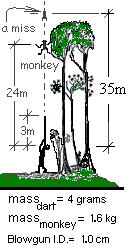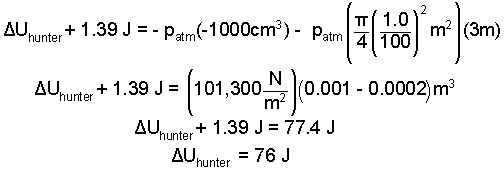| THERMO Spoken Here! ~ J. Pohl © | TOC NEXT ~ 150 |
Blowgun Hunter

Men in the Amazon forrest use long wooden tubes called blowguns to kill monkeys and birds for dinner. A monkey in sight, the hunter quietly slips a poisoned dart into the tube then lifts it near vertical. Upon a slowly drawn, deep breath, the hunter contracts his chest and "blows" the dart skyward. When successful, the dart hits the monkey and it falls to the ground. The image shows geometry of a hunt.
Calculate the least muzzle velocity of the dart.
♦ In a final design one must address effects of friction. However, for expedience, initial calculations are always done for the system event "assumed ideal," that is, with friction set to zero.
For the "muzzle velocity" we take the dart as system and the event to be a "miss." Seeking to calculate the dart muzzle velocity, we set the event to start the instant the dart leaves the blowgun and to end when the dart attains zero-velocity at its maximum height (indicated as 32 meters above the blowgun muzzle). Our new energy equation includes terms for internal energy, compression work and heat:

| (1) 1 |
Work left to right. The internal energy of the dart is a function of its temperature and specific volume. The dart is a solid object with constant temperature and no change of specific volume (or volume) over the event, hence there is no change of its internal energy (X). There will be kinetic and potential energy changes. Compression work of the event is zero because dVdart = 0 . There are no components of work except friction of moving through air which we assume is small ( / ). The sum of heats is initially zero, and with little friction, temperatures will not change and no motive for heat will be created: ΣQ = 0. The next equation contains four strike-outs, "X", which mean "is zero" and one strike-through, " /," which means "small" in comparison to other terms, therefore ignored.

| (2) 2 |
Next we expand the above implicit statement and enter the numbers.

| (3)3 |
Comment.

| (4) 4 |

| (5) 5 |
Calculate the work of the dart.
♦ The dart is the system. Friction being disregarded, the principle work of the dart happens when it is blown up the tube of the blow gun.
The sketch shows the dart initially at the tube bottom 1), then at the top, just outside the tube, with the muzzle velocity we just calculated. ΔU of the dart is associated with the ΔT or Δv of the dart, neither changes happens ( notated as X). There will be a ΔKE and a ΔPE. The dart volume will not change; compression work is zero (X). We assume the friction will be negligibly small ( notated as / ). Finally the event occurred quickly so ΣQ = 0, (X). The energy equation with dropped terms is:

| (6) 6 |
We write ΔKE and ΔPE of the dart explicitly then apply numbers.

| (7) 7 |
The initial velocity of the dart is zero. The elevation change of its center of mass is 3 meters.

| (8) 8 |

| (9) 9 |
The muzzle velocity used above (v2) assumed no friction of upward flight of the dart. This calculation assumed no friction of the dart in the tube. Hence, this work calculated is the least work required of the hunter.
What average pressure was required of the hunter to blow the dart ?
♦ In the previous parts of this discussion of the dart we carried the work term as ΣW. With this calculation we expand that sum. After taking a deep breath, the hunter collapses his chest and diaphragm to expel air from his lungs. A pressure-force is caused to act over the bottom area of the dart. This pressure-force displaces up the tube. And as the dart moves upward, it must push away the atmospheric air ahead of it in the tube. Ignoring friction, the event has two forces and two components of work.

| (10) 10 |
comment

| (11)11 |
We have the magnitude of the work from an above calculation. Atmospheric pressure is 101,300 Pa. Thus:

| (12) 12 |
What energy change did the hunter experience? Obviously, physical exertion or "lung power" of the hunter fired the dart. The first step of the hunter was his deep breath. We assume his chest volume increased approximately 1000 cubic centimeters. We take the hunter and the dart as system. We strike friction and heats of the event and write the energy.

| (13)13 |
Expand the equation to address the hunter and the dart, individually. Also recognize kinetic and potential energy changes of the hunter are zero and the change of internal energy and volume (compression work) are zero for the dart.

| (14) 14 |
The work terms are special. When the hunter blows the dart his chest volume decreases by 1000 cubic centimeters. Thus the atmosphere collapses over the outside surface of his chest and helps blow the dart. In addition blowing the dart requires that the atmospheric pressure-force acting over the top area of the dart be displaced upward the length of the tube. This is work of the event passing from the system to the surrounding atmosphere.

| (15) 15 |
Subject to our assumptions, this result indicates an approximate efficiency of the blowgun event. The work accomplished on the dart amounted to 1.39 Joules. The "effort" of the hunter was 76 J. The efficiency of the event is (1.4J/76J) x 100 = 1.8%.

Blowgun Hunter
Men hunt monkeys and birds in the Amazon forest using long wooden tubes called blowguns. A monkey in sight, the hunter slips a poisoned dart into the tube and quietly lifts it to vertical. Taking a deep breath and a steady aim, he contracts his chest to blow the dart skyward. When successful, the dart hits a monkey and it falls to the ground. The image shows geometry of a hunt.
Calculate the least muzzle velocity of the dart.
Premise presently unwritted!